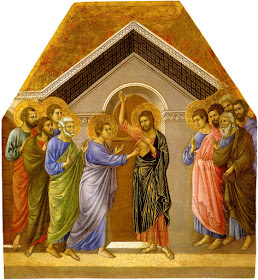 But perhaps for me, the Benedictines are most closely associated with the Sacred Heart due to their outstanding working in promoting the Adoration of the Blessed Sacrament. If St. Benedict was a light in the darkness of the middle ages, the sisters in Paris ( Sacré-Cœur), London (Tyburn) and all over the world (Colombia, Ecuador, Peru, Australia, New Zealand, Scotland, Ireland) are a great light in our present darkness. To know that, at any time in the day or night, the sisters are kneeling in quiet contemplation and adoration is, for me, a profound comfort. So mindful of the great work of the Benedictine sisters in maintaining a perpetual adoration of the Sacred Heart in the Blessed Sacrament I can only offer the prayer for the canonisation of the founder of the Tyburn convent: Marie Adele Garnier (1838- 1924). Visit Tyburn and find out about their inspiring work HERE. For Tyburn monasteries elsewhere, go HERE . And for the Parisian Benedictines in the Sacré-Cœur, ICI
But perhaps for me, the Benedictines are most closely associated with the Sacred Heart due to their outstanding working in promoting the Adoration of the Blessed Sacrament. If St. Benedict was a light in the darkness of the middle ages, the sisters in Paris ( Sacré-Cœur), London (Tyburn) and all over the world (Colombia, Ecuador, Peru, Australia, New Zealand, Scotland, Ireland) are a great light in our present darkness. To know that, at any time in the day or night, the sisters are kneeling in quiet contemplation and adoration is, for me, a profound comfort. So mindful of the great work of the Benedictine sisters in maintaining a perpetual adoration of the Sacred Heart in the Blessed Sacrament I can only offer the prayer for the canonisation of the founder of the Tyburn convent: Marie Adele Garnier (1838- 1924). Visit Tyburn and find out about their inspiring work HERE. For Tyburn monasteries elsewhere, go HERE . And for the Parisian Benedictines in the Sacré-Cœur, ICIFATHER, all-powerful & ever-living God,
we give you glory, praise and thanks
for the life and virtue
of your beloved daughter, Marie Adele Garnier.
Filled with the riches of your grace
and preferring nothing to the love
of the Heart of Jesus Christ,
she devoted her whole life
to the adoration, praise and glory
of your Name;
she sacrificed herself by prayer and penance
for the unity & holiness of your Church;
she loved her neighbour with a charity
full of humility and compassion.
Above all, she found the SUN of her life
in the Holy Mass,
and so was consumed with zeal
for liturgical worship
and eucharistic adoration,
and abandoned herself with all her heart
to your most Holy Will in all things.
In your mercy Lord, hearken to our prayer
"Glorify your Servant
Mother Marie Adele Garnier,
that your Servant
may glorify YOU".
We ask you this through our Lord
Jesus Christ,
AMEN.
May the Sacred Heart in the Blessed Sacrament that is so beautifully adored by the Benedictine sisters be the SUN in our lives and in the life of a world in darkness.



